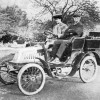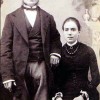It’s been called England’s finest Georgian rural market town. The streets around the Market Square are very much as they were rebuilt after a disastrous fire in 1731 that started in a tallow chandler’s. I quaffed a cider on the site: it’s now the King’s Arms, just off Salisbury Road, 100 yards from the square. Only 150 yards further on, the Ryves Almshouses escaped the fire because the roof was tile instead of thatch. The building was just less than 50 years old at the time of the conflagration: rebuilding of the town took around 40 years.
In Salisbury Road over a cycle shop is an inscription in memory of Alfred Stevens who created the impressive memorial to the Duke of Wellington in St. Paul’s Cathedral. (Visit Archived Articles Section and click on ‘Alfred Stevens – Painter and Sculptor.’ Pub. July 2003. Ed.) Nearby, at the entrance to the United Reformed Church, men were converting into flats a butcher’s and a printer’s, evidence of the fast increasing population. People must like Blandford.
After a generous pot of tea in the friendly Half Crown Café, I crossed the Market place to talk to Police Constable Liz Spicer, who patrols the town with a purposeful stride. “I like getting out and talking to people” she told me. But in this Georgian show place, down the road from Bryanstone School with its grand entrance arch and drive, on this day she was talking to magazine sellers, beggars and drifters, of whom I saw less than half a dozen all day.
Well, every town has had beggars and rough sleepers over the centuries. At the end of the afternoon I nearly became one myself, when my Editor was late turning up! In this connection, one of the inscriptions chiselled in professional manner into the kerbs and pavements says: “We’re all in the gutter, but some of us are looking at the stars.” Well, that’s nice to know. The Rogers family are thought to have contributed to the earlier 15th century church. They owned much of Blandford and were Stewards there for hundreds of years.
Another inscription relating to the Bastard family name and a “careless tallow chandler” I would rather not repeat. It was the founders of the famous Blandford School of Architects, John and William Bastard, who rebuilt the church and Town Hall after the fire, which incidentally followed another in 1713. Only primitive ‘fire engines’ were available.
What dominates the town centre as it is on an island of high ground is this parish church of Saints Peter and Paul. Much of its contents survived from earlier times. And in the museum opposite are archaeological finds from a garden dig, which pre-date the church: they go back to the 17th century. Here is a scrap of paper with the draft wording in John Bastard’s own hand for his fire memorial of 1760, the arched construction in one corner of the churchyard. The Bastard family home is said to be nearby.
The museum has pictures of the railway station demolished in the late 1960’s and of “Blandford Forum”, the apple-green express passenger locomotive of the “West Country” class. Happy days! Unusually, there are also stone cuttings from buildings and pavements in the town and a large case entitled “Victorian Blandford.” In charge of the museum when I had a look around was a conversational Jewish lady who told me, on inquiry, that she escaped to Britain as a girl in 1938 from Vienna.
In the Close beyond and uphill from the church is one of the few buildings which survived the fire – the Old House – and the handsome Post Office and helpful library. Around the corner in Dorset Street I took a photograph of the one-time home of an honorary freeman of the borough. He was Jack Counter, who won the Victoria Cross in France in the First World War. If the Bastards were two of Blandford’s 18th century heroes, Jack Counter was one to bring honour to the town in the twentieth. His home is now Dorset House.
The Great Fire caused the deaths of 13 people and 480 families were made homeless. That is a measure of the disaster, which came upon a town, which by the previous century had become an important stage on the Exeter to London coach route. Someone has said: “The location of the town…has made it a natural centre since mediaeval times.”
Approaching it you look down on it lying in a broad valley between the grand rolling chalk downs, which have proved excellent for military exercises, and is why the headquarters of the Royal Corps of Signals is found here and has an excellent museum of its own, tracing the history of military communications.
Once there were cottage industries, making bone lace, buttons and gloves. Today sees expanding light industries, but the town actually depends on its shops and businesses.
Despite the existence of an eastern bypass, opened nearly 20 years ago, there is a constant stream of traffic through the town all day at around 10 m.p.h. which makes crossing the road hard for pedestrians, and this is where the crossings come into their own. A local motorist told me that it’s simply quicker to drive through the town, which stands the reasoning for bypasses on its head.
I asked which way to the river, was directed down a side road and was soon there. What a wonderful sward of grass, with a millstream running through it. And there was the Stour, much covered with green duckweed. Downstream the meadows were once the park of Lord Portman’s Bryanstone House, now a public school, as we have seen. No development is allowed here.
I approached the handsome suspension bridge leading to Blandford St. Mary village and its brewery, which rises up, as all breweries seem to, like some bizarre continental castle with distinctive chimney and smell of malt and hops. About 100 tonnes of barley are trucked in every week, and hops come from Kent or Worcestershire, and even Bavaria. Some 450 people work here, and at full pressure 57,000 cans or 18,000 bottles can be filled every hour. When you think that beer sales are falling as drinkers get older, this factory needs to make the most of its quality products. In fact, soft drinks are also produced, and actually account for 55 per cent of total volume.
Before leaving Blandford, the visitor should not miss the Crown Hotel and the Greyhouse and Red Lion buildings. The Great Dorset Steam fair, held near the town for the greater part of a week in the late summer or early autumn, brings crowds to visit the greatest show of its kind not only in the land but in the world, with around 100 fair organs and probably the greatest working display of steam traction and stationary engines anywhere.
In an entirely different sphere is the restored St. Leonard Chapel, a leper hospice in the 13th century as originally built, and which has apparently not been used as a chapel since 1760.
It was in the later mediaeval period that Blandford Forum, as it is generally known, developed as one of the major market towns in eastern Dorset. All through history it has been an important crossing-point of the Stour, at first by ford. Here the main roads from Poole to Shaftesbury and Salisbury to Dorchester meet. In 40 year the population has grown from 3,000 to around 9,000 – a staggering rise. People obviously like the place.
At the end of the day, from its restaurants, bistros, pubs and cafes, I chose a takeaway opposite the parish church and went home with a huge burger, salad and French fries. A cool late September breeze was blowing as we climbed the downs and distanced ourselves from Blandford and in an hour it was quite dark over the Dorset hills.
This article was first published on our earlier site in November 2003



